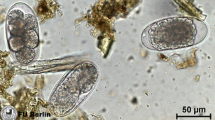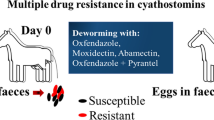Abstract
A cross-sectional survey was performed on ten stud farms in western Anatolia, Turkey, in order to provide the first information on the problem of anthelmintic resistance in equine strongyles in this country. Benzimidazole (BZ) resistant cyathostomin populations were detected on seven farms if pre- and post-treatment egg counts are compared in treated animals and the resistance is defined as a mean faecal egg count reduction (FECR) of <95% with a lower 95% confidence limit of <90%. Egg hatch tests using an ED50 of 0.1 μg/ml thiabendazole as the cut-off value confirmed BZ resistance on four of the seven farms. The probable reasons for the occurrence of BZ resistance are discussed. Resistance to pyrantel embonate or macrocyclic lactones, evaluated on five and six farms, respectively, was not detected using the FECR test.
Similar content being viewed by others
References
Anonymous (2000) Republic of Turkey, Prime Ministry State Institute of Statistics: Number of livestock by kind. SIS 2000 (http://www.die.gov.tr/IstTablolar/13ta177 t.xls)
Bauer C (1990) Praktikum der Veterinärmedizinischen Parasitologie 2nd edn. Ferbersche Universitätsbuchhandlung, Giessen
Bauer C, Merkt JC, Janke-Grimm G, Bürger H-J (1986) Prevalence and control of benzimidazole-resistant small strongyles on German thoroughbred studs. Vet Parasitol 21:189–203
Bjørn H, Roepstorff A, Waller PJ, Nansen P (1990) Resistance to levamisole and cross-resistance between pyrantel and levamisole in Oesophagostomum quadrispinulatum and Oesophagostomum dentatum of pigs. Vet Parasitol 37:21–30
Coles GC, Bauer C, Borgsteede FHM, Geerts S, Klei TR, Taylor MA, Waller PJ (1992) World Association for the Advancement of Veterinary Parasitology (W.A.A.V.P.) methods for the detection of anthelmintic resistance in nematodes of veterinary importance. Vet Parasitol 44:35–44
Collobert C, Bernard N, Lamidey C, Kerboeuf D, Hubert J (1996) Résistance des cyathostomes du cheval aux dérivés du benzimidazole en Normandie. 22e Journée de la Recherche Équine. Institut du Cheval, Paris, pp 80–89
Craven J, Bjørn H, Henriksen SA, Nansen P, Larsen M, Lendal S (1998) Survey of anthelmintic resistance on Danish horse farms, using 5 different methods of calculating faecal egg count reduction. Equine Vet J 30:289–293
Craven J, Bjørn H, Barnes EH, Henriksen SA, Nansen P (1999) A comparison of in vitro tests and a faecal egg count reduction test in detecting anthelmintic resistance in horse strongyles. Vet Parasitol 85:49–59
Gerwert S, Failing K, Bauer C (2002) Prevalence of levamisole and benzimidazole resistance in Oesophagostomum populations of pig-breeding farms in North Rhine-Westphalia, Germany. Parasitol Res 88:63–68
Ihler CF, Bjørn H (1996) Use of two in vitro methods for the detection of benzimidazole resistance in equine small strongyles (Cyathostoma spp.). Vet Parasitol 65:117–125
Kaplan RM (2002) Anthelmintic resistance in nematodes of horses. Vet Res 33:491–507
Königová A, Várady M, Čorba J (2003) Comparison of in vitro methods and faecal egg count reduction test for the detection of benzimidazole resistance in small strongyles of horses. Vet Res Commun 27:281–288
Martin RJ (1997) Modes of action of anthelmintic drugs. Vet J 154:11–34
Ministry of Agriculture, Fisheries and Food (1986) Manual of Veterinary Parasitological Laboratory Techniques, 3rd edn. Her Majesty’s Stationery Office, London
Papadopoulos E, Hamhougias K, Himonas C, Dorchies P (2000) Strongyle anthelmintic resistance in horses and cattle in Greece. Rev Méd Vét 151:1139–1142
Parr SL, Strickland KL, O’Brien DJ (1993) The prevalence of benzimidazole resistance in the small strongyles of horses in Ireland. Proceedings of the 14th Conference of the World Association for the Advancement of Veterinary Parasitology, Cambridge, abstract no. 376
Pook JF, Power ML, Sangster NC, Hodgson JL, Hodgson DR (2002) Evaluation of tests for anthelmintic resistance in cyathostomes. Vet Parasitol 106:331–343
Sangster NC, Whitlock HV, Russ IG, Gunawan M, Griffin DL, Kelly JD (1979) Trichostrongylus colubriformis and Ostertagia circumcincta resistant to levamisole, morantel tartrate and thiabendazole: occurrence of field strains. Res Vet Sci 27:106–110
Whitlock HV, Kelly JD, Porter CH, Griffin DL, Martin ICA (1980) In vitro field screening for anthelmintic resistance in strongyles of sheep and horses. Vet Parasitol 7:215–232
Acknowledgements
The authors thank the manager of the farms for their kind cooperation and acknowledge the donation of anthelmintics from Bayer Vital Germany, Boehringer Ingelheim Germany, Ceva Germany, Fort Dodge Germany, Intervet Germany, Topkim Turkey and Virbac Germany. The survey was supported by the Scientific and Technical Research Council of Turkey (TÜBİTAK).
Author information
Authors and Affiliations
Corresponding author
Rights and permissions
About this article
Cite this article
Çirak, V.Y., Güleğen, E. & Bauer, C. Benzimidazole resistance in cyathostomin populations on horse farms in western Anatolia, Turkey. Parasitol Res 93, 392–395 (2004). https://doi.org/10.1007/s00436-004-1143-3
Received:
Accepted:
Published:
Issue Date:
DOI: https://doi.org/10.1007/s00436-004-1143-3




